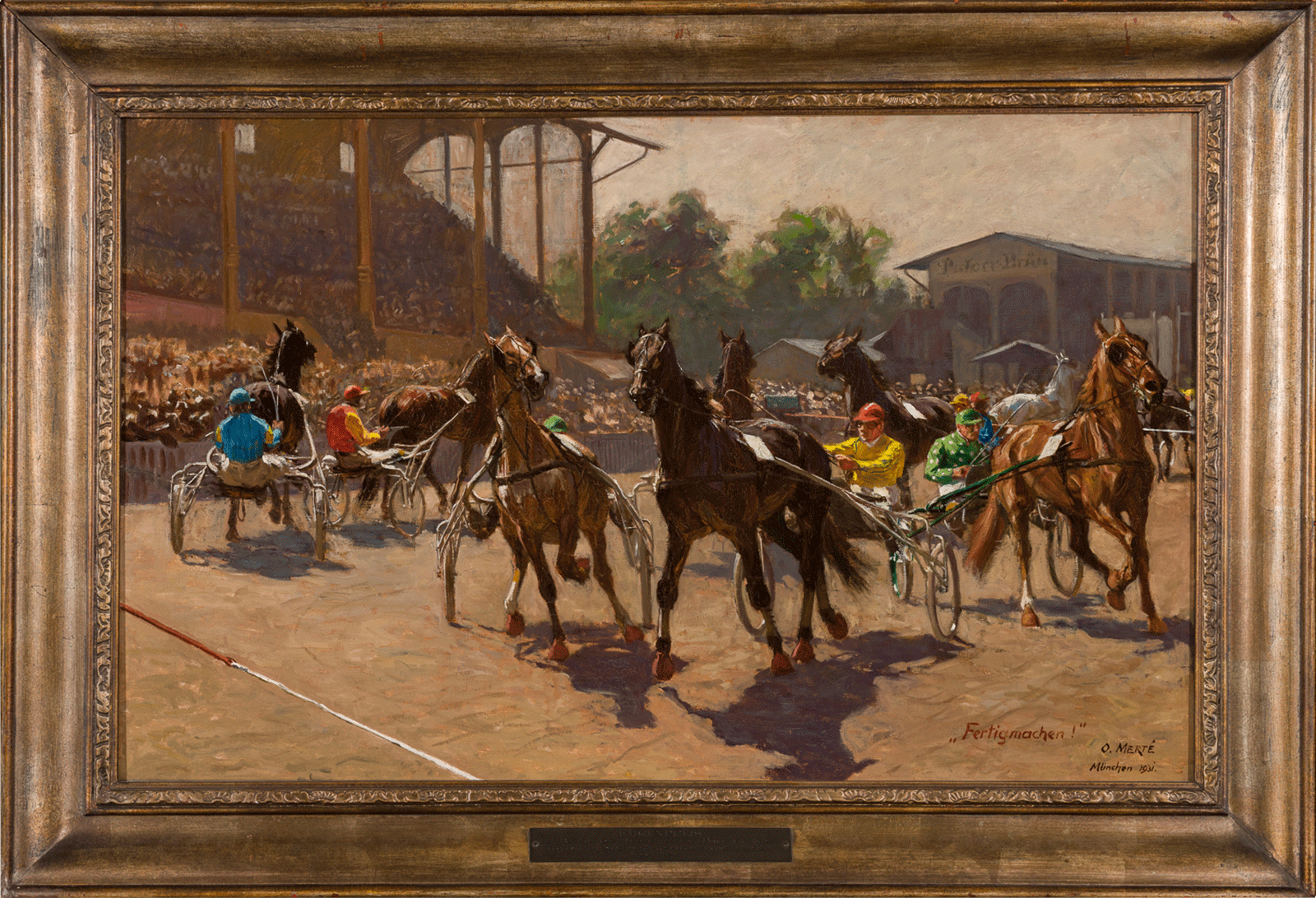2020 Fine Sporting Art, American Paintings, and Sculpture
99| Oskar Merte (German, 1872-1938)
Fertigmachen!
$2,875.00
After World War I devastated the German psyche, the Reich developed a renewed interest in creating a strong sense of German nationalism. This led German trotting centers to give racing events a new face that would entice international participation in order to improve the country?s breeding standard. The first race of this nature, the Matadoren race, was held in Mariendorf in 1919. In the next few years other German trotting clubs followed suit, creating races of their own with large enough purses to attract foreign competition.
The Munich Trotting and Breeding Club organized the Bavarian Grand Prix in 1922. A sensation in its founding year, the race was endowed with 100,000 marks, the largest purse in Germany at the time. A preliminary race in its initial years, the Gro? Preis von Bayern became an international stitch race from 1928 until 1962. In 1963 it officially fulfilled its purpose in raising the German trotting standard as an international top test, enticing the best 3-year-old trotters from Europe and around the world.
This piece depicting the 1931 Gro?e Preis von Bayern was commissioned by the Munich City Council as a high honor for the winner. That year an American horse, Enzian, captured the prize. Enzian had esteemed Standardbreds on both sides of his pedigree, with connections to Peter the Great and Mambrino Patchen (see lot #28).
Oil on canvas, 20" x 32"
$3000. - $5000.
After World War I devastated the German psyche, the Reich developed a renewed interest in creating a strong sense of German nationalism. This led German trotting centers to give racing events a new face that would entice international participation in order to improve the country?s breeding standard. The first race of this nature, the Matadoren race, was held in Mariendorf in 1919. In the next few years other German trotting clubs followed suit, creating races of their own with large enough purses to attract foreign competition. The Munich Trotting and Breeding Club organized the Bavarian Grand Prix in 1922. A sensation in its founding year, the race was endowed with 100,000 marks, the largest purse in Germany at the time. A preliminary race in its initial years, the Gro? Preis von Bayern became an international stitch race from 1928 until 1962. In 1963 it officially fulfilled its purpose in raising the German trotting standard as an international top test, enticing the best 3-year-old trotters from Europe and around the world. This piece depicting the 1931 Gro?e Preis von Bayern was commissioned by the Munich City Council as a high honor for the winner. That year an American horse, Enzian, captured the prize. Enzian had esteemed Standardbreds on both sides of his pedigree, with connections to Peter the Great and Mambrino Patchen (see lot #28).
After World War I devastated the German psyche, the Reich developed a renewed interest in creating a strong sense of German nationalism. This led German trotting centers to give racing events a new face that would entice international participation in order to improve the country?s breeding standard. The first race of this nature, the Matadoren race, was held in Mariendorf in 1919. In the next few years other German trotting clubs followed suit, creating races of their own with large enough purses to attract foreign competition. The Munich Trotting and Breeding Club organized the Bavarian Grand Prix in 1922. A sensation in its founding year, the race was endowed with 100,000 marks, the largest purse in Germany at the time. A preliminary race in its initial years, the Gro? Preis von Bayern became an international stitch race from 1928 until 1962. In 1963 it officially fulfilled its purpose in raising the German trotting standard as an international top test, enticing the best 3-year-old trotters from Europe and around the world. This piece depicting the 1931 Gro?e Preis von Bayern was commissioned by the Munich City Council as a high honor for the winner. That year an American horse, Enzian, captured the prize. Enzian had esteemed Standardbreds on both sides of his pedigree, with connections to Peter the Great and Mambrino Patchen (see lot #28).
To Leave An Absentee Bid, Please Enter An Amount Below


